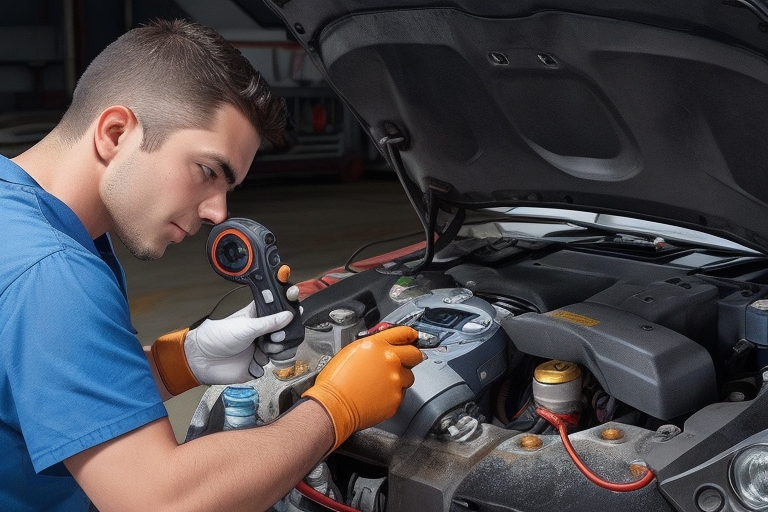Do you ever feel like your car is struggling to catch its breath? It’s like it’s gasping for air, causing rough idling and sluggish acceleration.
Well, the culprit might just be your idle air control valve. This little guy is responsible for regulating the airflow to your engine, and if it’s not working properly, your car’s performance will suffer.
But fear not! In this article, we’ll show you how to test your idle air control valve, so you can get your car back on track.
Key Takeaways
- The Idle Air Control Valve regulates airflow to the engine while idling.
- Testing the resistance of the valve with a multimeter can help identify problems.
- Thoroughly cleaning the valve can remove dirt, oil, and contaminants.
- Regular maintenance and cleaning can prolong the life of the Idle Air Control Valve.
Understanding the Idle Air Control Valve
You can gain a better understanding of the Idle Air Control Valve by familiarizing yourself with its benefits and learning how to clean it properly.
The Idle Air Control Valve plays a crucial role in regulating the amount of air that enters the engine while idling.
By cleaning it regularly, you can experience several benefits.
Firstly, you’ll notice a better response time when accelerating, allowing for smoother and more efficient driving.
Additionally, cleaning the Idle Air Control Valve can lead to improved fuel economy, saving you money at the pump.
Furthermore, you’ll enjoy an overall improved performance with fewer engine noises.
Lastly, cleaning the valve helps remove built-up carbon and harmful deposits, ensuring the longevity of your engine.
Gathering the Necessary Tools and Equipment
To properly clean the Idle Air Control Valve, gather the necessary tools and equipment. This includes a socket wrench and cleaning solution. These tools will help you effectively remove any built-up dirt or debris that may be affecting the valve’s performance.
Additionally, you may need a small brush or toothbrush to scrub away any stubborn residue. Make sure to have some rags or paper towels handy to wipe away any excess cleaning solution.
It’s also a good idea to have some gloves on hand to protect your hands from any harsh chemicals in the cleaning solution.
Once you have all your tools and equipment gathered, you’ll be ready to start the cleaning process and get your Idle Air Control Valve working like new again.

Step-By-Step Guide for Testing the Idle Air Control Valve
After removing the Idle Air Control Valve, connect a multimeter to the electrical terminals and measure the resistance. Ensure that the engine is turned off and the ignition key is in the ‘off’ position.
This step is crucial in testing the functionality of the Idle Air Control Valve. Once the multimeter is connected, you can check if the resistance falls within the acceptable range.
If the resistance is too high or too low, it indicates a problem with the valve and it may need to be replaced.
It’s important to follow this step carefully to accurately diagnose any issues with the Idle Air Control Valve.
Remember to take all necessary precautions and refer to the manufacturer’s instructions for additional guidance.
Troubleshooting Common Issues With the Idle Air Control Valve
An easy way to troubleshoot common issues with the idle air control valve is to inspect the valve for any signs of dirt or debris. Start by visually examining the valve and its surrounding area. Look for any buildup of dirt, oil, or other contaminants that could be affecting its performance.
If you notice any signs of dirt or debris, it’s important to clean the valve thoroughly. Disconnect the valve from the intake manifold and use a suitable cleaning solution to remove any buildup. After cleaning, reinstall the valve and test its operation.
If the issue persists, further inspection or professional assistance may be required. Remember, keeping the idle air control valve clean is crucial for optimal engine performance and fuel efficiency.
Tips for Maintaining and Prolonging the Life of the Idle Air Control Valve
If you want to maintain and prolong the life of the idle air control valve, regularly cleaning it and using quality cleaning products are essential.
Cleaning the valve helps remove carbon and deposits that can build up over time, leading to better performance and fuel economy.
There are several products available for cleaning the idle air control valve, such as the 3M Intake System Cleaner Kit and CRC Throttle Body and Air Intake Cleaner.
When cleaning the valve, you’ll need to locate it, disconnect the intake hose and battery cable, remove screws and plugs, and apply the cleaner.
After cleaning, remount the valve, reconnect everything, and start the engine to check the process.
If idling is still rough, it may be necessary to schedule an appointment with a local automotive shop for further inspection and potentially replace the valve.
Frequently Asked Questions
Can a Faulty Idle Air Control Valve Cause the Check Engine Light to Come On?
Yes, a faulty idle air control valve can cause the check engine light to come on. It is important to properly diagnose and address the issue to avoid further damage to your vehicle.
What Are the Symptoms of a Failing Idle Air Control Valve?
Experiencing rough idling, stalling, or fluctuating RPMs? These are symptoms of a failing idle air control valve. It’s crucial to diagnose the issue to ensure optimal engine performance.
Can a Dirty or Clogged Idle Air Control Valve Affect the Performance of Other Engine Components?
Yes, a dirty or clogged idle air control valve can affect the performance of other engine components. It can lead to rough idling, decreased fuel efficiency, and overall poor engine performance.
Is It Possible to Clean a Faulty Idle Air Control Valve, or Does It Need to Be Replaced?
It is possible to clean a faulty idle air control valve before considering replacement. Cleaning can remove built-up carbon and deposits, improving performance. If cleaning doesn’t solve the issue, replacement may be necessary.
How Often Should the Idle Air Control Valve Be Inspected or Serviced?
The idle air control valve should be inspected and serviced regularly to ensure optimal performance. Schedule regular check-ups with a local automotive shop to prevent any potential issues and keep your engine running smoothly.
Conclusion
So there you have it, folks! Testing your idle air control valve is a simple and effective way to ensure your car is running smoothly.
By following our step-by-step guide and using a multimeter, you can easily diagnose any issues and determine if cleaning or replacement is necessary.
Remember, a well-maintained idle air control valve is essential for optimal engine performance.
So don’t wait, give your car the TLC it deserves and keep on cruising!
